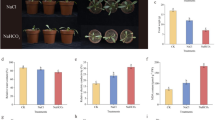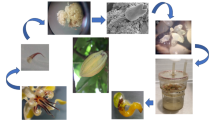Abstract
2-(2-Phenylethyl)chromones are main classes of aromatic compounds isolated from agarwood, the resinous portion derived from Aquilaria sinensis used as traditional medicine, incense and perfume. However, the mechanisms of biosynthesis of 2-(2-phenylethyl)chromones and agarwood formation are still unknown. Previous studies indicated that 6,7-dimethoxy-2-[2-(4′-methoxyphenyl)ethyl]chromone (AH8) and 6,7-dimethoxy-2-(2-phenylethyl)chromone (AH6) were more sensitive to salt stress and can be used as markers to analyze the production of 2-(2-phenylethyl)chromones. In this study, the content of AH6 and AH8 was analyzed by an AB Sciex 5500 Qtrap mass spectrometer and the congeners of 2-(2-phenylethyl)chromones were detected by LC-DAD-IT-TOF-MS system in A. sinensis calli under various abiotic stresses and hormone treatments. Among the abiotic stresses, salt and drought stress remarkably increased the production of AH6 and AH8, and could induce 41 and 23 species of 2-(2-phenylethyl)chromones, respectively. However, cold treatment has little influence on the production of 2-(2-phenylethyl)chromones. Ion stresses induced by KNO3, CaCl2, and (NH4)2SO4 also significantly increased the content of AH6 and AH8, and could induced 14, 18, and 14 congeners of 2-(2-phenylethyl)chromones, respectively. Exogenous hormones including MeJA, SA and ABA induced a small amount of 2-(2-phenylethyl)chromones in calli within 20 days, while 6, 5, and 7 species of 2-(2-phenylethyl)chromones were detected after MeJA, SA and ABA treatment, respectively. Our study would provide solid basis for further research on biosynthesis of 2-(2-phenylethyl)chromones and agarwood formation.



Similar content being viewed by others
Abbreviations
- MeJA:
-
Methyl jasmonate
- SA:
-
Salicylic acid
- ABA:
-
Abscisic acid
- NAA:
-
Naphtha acetic acid
- 6-BA:
-
6-Benzyladenim
- 2,4-D:
-
Dichlorophenoxyacetic acid
- KT:
-
Kinetin
- DW:
-
Dry weight
- AH6 :
-
6,7-Dimethoxy-2-(2-phenylethyl)chromone
- AH8 :
-
6,7-Dimethoxy-2-[2-(4′-methoxyphenyl)ethyl]chromone
- HRESIMS:
-
High resolution electrospray ionization mass spectroscopy.
References
Chen D, Xu ZR, Chai XY, Zeng KW, Jia YX, Bi D, Ma ZZ, Tu PF (2012a) Nine 2-(2-phenylethyl)chromone derivatives from the resinous wood of Aquilaria sinensis and their inhibition of LPS-induced NO production in RAW 264.7 Cells. Eur J Org Chem 2012(27): 5389–5397
Chen HQ, Wei JH, Yang JS, Zhang Z, Yang Y, Gao ZH, Sui C, Gong B (2012b) Chemical constituents of agarwood originating from the endemic genus Aquilaria plants. Chem Biodivers 9(2):236–250
Docimo T, Davis AJ, Luck K, Fellenberg C, Reichelt M, Phillips M, Gershenzon J, D’Auria JC (2015) Influence of medium and elicitors on the production of cocaine, amino acids and phytohormones by Erythroxylum coca calli. Plant Cell Tiss Org 120(3):1061–1075
Gao ZH, Wei JH, Yang Y, Zhang Z, Zhao WT (2012) Selection and validation of reference genes for studying stress-related agarwood formation of Aquilaria sinensis. Plant Cell Rep 31(9):1759–1768
Ibrahim SRM, Mohamed GA (2015) Natural occurring 2-(2-phenylethyl) chromones, structure elucidation and biological activities. Nat Prod Res 29(16):1489–1520
Kumeta Y, Ito M (2010) Characterization of delta-guaiene synthases from cultured cells of Aquilaria, responsible for the formation of the sesquiterpenes in agarwood. Plant Physiol 154(4):1998–2007
Kurusu T, Kuchitsu K, Tada Y (2015) Plant signaling networks involving Ca2+ and Rboh/Nox-mediated ROS production under salinity stress. Front Plant Sci 6:427
Li W, Cai CH, Dong WH, Guo ZK, Wang H, Mei WL, Dai HF (2014a) 2-(2-Phenylethyl)chromone derivatives from Chinese agarwood induced by artificial holing. Fitoterapia 98:117–123
Li Y, Nie Y, Zhang Z, Ye Z, Zou X, Zhang L, Wang Z (2014b) Comparative proteomic analysis of methyl jasmonate-induced defense responses in different rice cultivars. Proteomics 14(9):1088–1101
Liu J, Wu J, Zhao YX, Deng YY, Mei WL, Dai HF (2008) A new cytotoxic 2-(2-phenylethyl)chromone from Chinese eaglewood. Chin Chem Lett 19(8):934–936
Liu YY, Chen HQ, Yang Y, Zhang Z, Wei JH, Meng H, Chen WP, Feng JD, Gan BC, Chen XY, Gao ZH, Huang JQ, Chen B, Chen HJ (2013) Whole-tree agarwood-inducing technique: an efficient novel technique for producing high-quality agarwood in cultivated Aquilaria sinensis trees. Molecules 18(3):3086–3106
Ma LY, Zhang H, Sun LR, Jiao YH, Zhang GZ, Miao C, Hao FS (2012) NADPH oxidase AtrbohD and AtrbohF function in ROS-dependent regulation of Na+/K+ homeostasis in Arabidopsis under salt stress. J Exp Bot 63(1):305–317
Murashige T, Skoog F (1962) A revised medium for rapid growth and bio assays with tobacco tissue cultures. Physiol Plant 15(3):473–497
Naef R (2011) The volatile and semi-volatile constituents of agarwood, the infected heartwood of Aquilaria species: a review. Flavour Fragr J 26:73–89
Nam BH, Jin HJ, Kim SK, Hong YK (1998) Quantitative viability of seaweed tissues assessed with 2,3,5-triphenyltetrazolium chloride. J Appl Phycol 10(1):31–36
Ntushelo K (2017) Effect of salicylic acid on the growth and chemical responses of pectobacterium carotovorum subsp. carotovorum. Pak J Biol Sci 20:278–288
Okudera Y, Ito M (2009) Production of agarwood fragrant constituents in Aquilaria calli and cell suspension cultures. Plant Biotechnol 26(2):307–315
Qi SY, He ML, Lin LD, Zhang CH, Hu LJ, Zhang HZ (2005) Production of 2-(2-phenylethyl) chromones in cell suspension cultures of Aquilaria sinensis. Plant Cell Tiss Org 83(2):217–221
Saha B, Borovskii G, Panda SK (2016) Alternative oxidase and plant stress tolerance. Plant Signal Behav 11(12):e1256530
She ZL, Wu L, Wang Q, Gao MC, Jin CJ, Zhao YG, Zhao LT, Guo L (2018) Salinity effect on simultaneous nitrification and denitrification, microbial characteristics in a hybrid sequencing batch biofilm reactor. Bioproc Biosyst Eng 41(1):65–75
Wang XH, Gao BW, Liu X, Dong XJ, Zhang Z, Fan HY, Zhang L, Wang J, Shi SP, Tu PF (2016) Salinity stress induces the production of 2-(2-phenylethyl)chromones and regulates novel classes of responsive genes involved in signal transduction in Aquilaria sinensis calli. BMC Plant Biol 16(1):119
Wang XH, Dong XJ, Feng YY, Liu X, Wang J, Zhang Z, Li J, Zhao YF, Shi SP, Tu PF (2018) H2O2 and NADPH oxidases involve in regulation of 2-(2-phenylethyl)chromones accumulation during salt stress in Aquilaria sinensis calli. Plant Sci 269:1–11
Wurms KV, Hardaker AJ, Ah Chee A, Bowen J, Phipps J, Taylor J, Jensen D, Cooney J, Wohlers M, Reglinski T (2017) Phytohormone and putative defense gene expression differentiates the response of ‘hayward’ kiwifruit to psa and pfm infections. Front Plant Sci 8:1366
Xu YH, Zhang Z, Wang MX, Wei JH, Chen HJ, Gao ZH, Sui C, Luo HM, Zhang XL, Yang Y, Meng H, Li WL (2013) Identification of genes related to agarwood formation: transcriptome analysis of healthy and wounded tissues of Aquilaria sinensis. BMC Genom 14:227
Yang DL, Wang H, Guo ZK, Dong WH, Mei WL, Dai HF (2014a) A new 2-(2-phenylethyl)chromone derivative in Chinese agarwood ‘Qi-Nan’ from Aquilaria sinensis. J Asian Nat Prod Res 16(7):770–776
Yang DL, Wang H, Guo ZK, Li W, Mei WL, Dai HF (2014b) Fragrant agarofuran and eremophilane sesquiterpenes in agarwood ‘Qi-Nan’ from Aquilaria sinensis. Phytochem Lett 8:121–125
Yoon JS, Lee MK, Sung SH, Kim YC (2006) Neuroprotective 2-(2-phenylethyl)chromones of Imperata cylindrica. J Nat Prod 69(2):290–291
Zhang XL, Liu YY, Wei JH, Yang Y, Zhang Z, Huang JQ, Chen HQ, Liu YJ (2012) Production of high-quality agarwood in Aquilaria sinensis trees via whole-tree agarwood-induction technology. Chin Chem Lett 23(6):727–730
Zhang YT, Zhang YL, Chen SX, Yin GH, Yang ZZ, Lee S, Liu CG, Zhao DD, Ma YK, Song FQ, Bennett JW, Yang FS (2015) Proteomics of methyl jasmonate induced defense response in maize leaves against Asian corn borer. BMC Genom 16(1):224
Acknowledgements
This research was supported by the National Natural Science Foundation of China (No. 81503182), Inner Mongolia Natural Science Foundation (No. 2017BS0803), Doctoral Foundation of Baotou Medical College (No. BSJJ201607) and Natural Science Foundation of Baotou Medical College (No. BYJJ-YF201608).
Author information
Authors and Affiliations
Contributions
XJD and BWG performed the experiments and wrote the draft of the manuscript. YYF and XL was involved in data analysis and manuscript preparation. JW, JLW, and PFT provided expert input in data analysis and critically revised the manuscript. XHW and SPS designed the research, supervised the work throughout and reviewed the manuscript. All the authors read and approved the final manuscript.
Corresponding authors
Ethics declarations
Conflict of interest
The authors declare that they have no conflict of interest.
Additional information
Communicated by Sergio J. Ochatt.
Rights and permissions
About this article
Cite this article
Dong, X., Gao, B., Feng, Y. et al. Production of 2-(2-phenylethyl)chromones in Aquilaria sinensis calli under different treatments. Plant Cell Tiss Organ Cult 135, 53–62 (2018). https://doi.org/10.1007/s11240-018-1442-5
Received:
Accepted:
Published:
Issue Date:
DOI: https://doi.org/10.1007/s11240-018-1442-5




